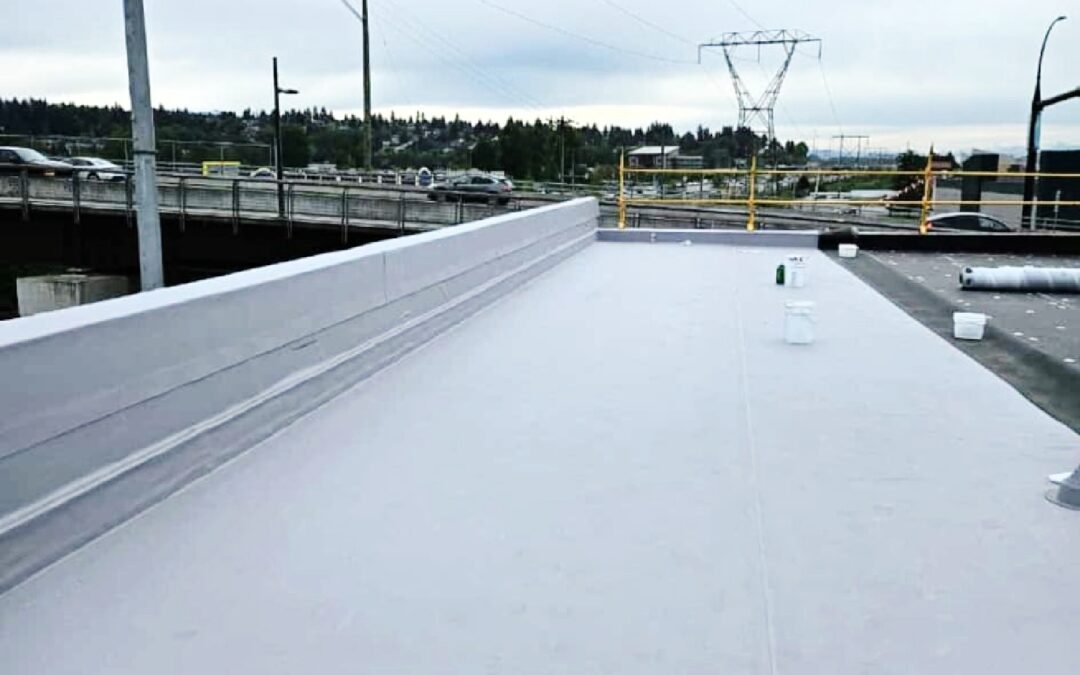Have you noticed unusual issues with your flat roof, like water pooling or wrinkles on the surface? These might be signs that your TPO roofing wasn’t installed correctly.
TPO roofing, short for thermoplastic polyolefin, has become a popular choice for flat and low-slope roofs, especially in industrial and commercial settings. First gaining traction in Europe, it made its way to North America in the 1990s and has been growing ever since. Today, TPO membranes hold a significant share of the roofing market, thanks to their energy efficiency and durability. In fact, the global market for TPO roofing is projected to reach $2.2 billion by 2024, proving its demand across various sectors.
But even the best materials can fail if installed improperly. Poor workmanship can turn a reliable industrial roofing solution into a costly problem. In this blog, we’ll uncover five clear signs that your TPO roofing wasn’t done right—and what you can do about it. Let’s get started!
Visible Wrinkles or Bubbles on the Surface
A smooth surface is one of the first things you should notice on properly installed TPO roofing. If your roof has visible wrinkles or bubbles, it’s a clear sign something went wrong during the installation process.
These imperfections might seem harmless at first, but they can lead to bigger problems. Wrinkles and bubbles can trap moisture under the TPO membranes, creating an environment for mold growth or even causing the material to degrade over time. For flat roofs, which already rely on proper drainage, this trapped moisture can weaken the structure and lead to costly repairs.
Improper handling of materials or rushing through the installation can cause these surface issues. If you spot wrinkles or bubbles on your roof, it’s a good idea to have a professional assess the damage. This is especially important for industrial TPO roofs, where even minor issues can affect the building’s overall efficiency and safety.
By addressing these problems early, you can prevent further damage and ensure your TPO roofing lasts as long as it should.
Loose or Missing Seams
The seams of your TPO roofing are its first line of defense against leaks and water damage. If the seams are loose, poorly welded, or even missing in some areas, it’s a strong indicator of improper installation.
Seams connect the TPO membranes, ensuring the roof stays watertight. When these connections fail, water can seep through and damage the layers beneath. This issue is particularly concerning for flat roofs, as they don’t naturally shed water as sloped roofs do. Over time, loose seams can lead to leaks, mold, and structural problems.
In industrial TPO roofs, faulty seams can also impact energy efficiency by allowing heat to escape or penetrate the building. This not only raises energy costs but also compromises the comfort of those working inside.
If you notice any loose or missing seams on your roof, it’s crucial to have a professional inspect and fix the problem. Properly welded seams are essential for the longevity and performance of your TPO roofing.
Pooling Water or Poor Drainage
Water pooling on your TPO roofing is a red flag that something isn’t right. Flat roofs are designed to handle rainwater efficiently, but if drainage is poor, you’ll notice water collecting in certain areas. This can lead to significant problems over time.
Standing water on flat roofs puts extra weight on the structure and increases the risk of leaks. Over time, the water can wear down the TPO membranes, reducing their durability and causing damage to the roof’s layers. In industrial TPO roofs, pooling water can be especially problematic, as it may disrupt operations if leaks make their way into the building.
Poor drainage is often the result of an improper slope during installation or blocked drainage systems. While TPO roofing is highly durable, it can’t perform its best when water isn’t directed away from the roof.
If you’re concerned about water pooling on your flat roof and want to learn more about its causes and solutions, check out this guide: The Ponding Water on My Flat Roof: Is It Normal? 5 Important Things You Should Know.
Regular inspections and maintenance can help ensure your roof’s drainage system is functioning correctly. If you notice water pooling after a rainstorm, it’s time to call in a professional to assess and address the issue before it leads to costly repairs.
Premature Cracks or Tears on TPO Roofing
TPO roofing is known for its durability, but if you notice cracks or tears appearing earlier than expected, it’s a sign that the installation wasn’t done properly. These flaws can quickly compromise your roof’s ability to protect your property.
Cracks and tears often happen when TPO membranes aren’t handled carefully during installation or when the roof isn’t secured tightly enough to withstand weather changes. Over time, exposure to UV rays, heavy rain, or temperature fluctuations can make these weak spots worse.
For flat roofs, even small tears can allow water to seep through, leading to leaks and damage to the underlying structure. In industrial TPO roofs, cracks can disrupt insulation and energy efficiency, which is especially concerning for buildings that rely on maintaining stable indoor conditions.
If you see any signs of premature cracking or tearing, don’t wait to address the issue. Having a professional inspect and repair the damage can prevent further problems and help extend the lifespan of your TPO roofing. Proper installation and regular maintenance are key to avoiding these costly issues.
Inadequate Flashing or Edge Details
Flashing and edge details are critical components of your TPO roofing system. They provide extra protection against wind, rain, and other environmental elements. If these areas are improperly installed or missing altogether, your roof becomes vulnerable to significant damage.
Flashing, which seals the edges of TPO membranes, helps prevent water from seeping into the roof’s structure. When flashing isn’t installed correctly, water can find its way in, leading to leaks and potential structural damage. Poorly finished edges can also make the roof more susceptible to wind uplift, which can loosen the TPO membranes over time.
For industrial TPO roofs, inadequate flashing can have an even bigger impact. These roofs often cover large areas, and weak edges can compromise the entire system. A simple oversight during installation can lead to costly repairs or premature roof failure.
To avoid these problems, ensure that the flashing and edge details are installed by experienced professionals. Regular inspections can help catch issues early, allowing you to maintain the durability and effectiveness of your TPO roofing. Protecting these critical areas is essential for a roof that stands the test of time.
CONCLUSION:
Your TPO roofing is a durable and cost-effective solution for flat and industrial roofs, but even the best materials can fail if not installed properly. Wrinkles, loose seams, pooling water, cracks, and inadequate flashing are clear signs that something went wrong during installation.
By recognizing these issues early, you can prevent small problems from turning into expensive repairs. Regular inspections and proper maintenance are key to ensuring your roof performs as it should, whether for a commercial building or an industrial facility.
If you’ve noticed any of these warning signs, don’t hesitate to contact a professional roofing expert. Addressing issues now can save you time, money, and headaches in the long run. Remember, a well-installed TPO roofing system is essential for protecting your property and ensuring peace of mind.

